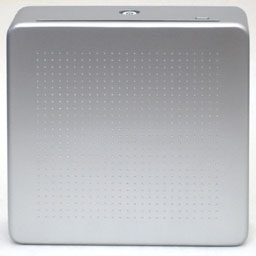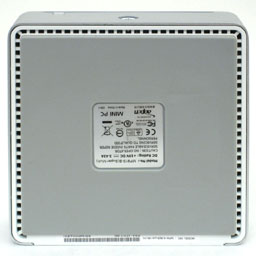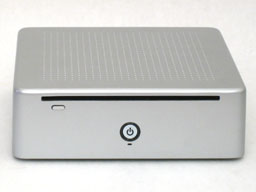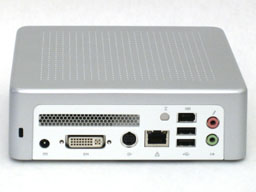Updated: AOpen MiniPC – Imitation is the Sincerest Form of Flattery
by Jarred Walton on March 3, 2006 12:05 AM EST- Posted in
- Systems
Appearance and System Specifications
To say that the AOpen MiniPC looks similar to the Mac Mini is an understatement. AOpen's own product marketing material contains numerous photographs comparing the two. Not everyone thinks that tiny PCs are cool looking or even necessary, but for those who do, the AOpen MiniPC is a very nice looking unit. Depending on where you purchase the MiniPC, you can find them in a variety of colors. Black, white, and silver are the most common, and the unit that we received is silver.
Other than the rear ports and the glowing blue power/HDD lights on the front, the case is a uniform silver. Also found on the front of the unit is the slot-load optical drive access and the accompanying eject button. The top has a grid of small indentations to add a bit of visual flare, while the sides and front are unadorned brushed aluminum. The bottom of the case has a rubberized non-slip pad with venting around the edges and a sticker containing product details, and that's about it. The case is, of course, very small, and you could easily hide it from view if desired, just like the Mac Mini. Technically, the MiniPC is slightly smaller than the Mac Mini (by about .5" in height), but basically, the system size is a tie.
One item that needs to be pointed out is the choice of interface. There are no legacy ports on the system; other than video and audio connections, the only interface for input devices and other components is provided by two USB 2.0 ports. Only two? That's right: if you want more than two devices, you're going to need a USB hub of some form. In fact, since you're going to use a mouse and keyboard for at least one port, a USB hub is almost required for expansion. You might try getting a keyboard with a couple of USB ports, but most likely, they will be USB 1.1, so you won't want to use them for high bandwidth devices. For testing, a Logitech Bluetooth keyboard and mouse combo was used, so that did leave a spare USB port. If you want to do anything more with the MiniPC, grab a powered USB 2.0 hub with at least four ports; they typically cost around $10 to $30, so it's not a major expense.
The Realtek ALC655 audio chip in the unit is capable of 5.1 sound, but apparently lack of room for the audio ports leaves only a speaker/headphone jack and a microphone jack. That should allow for up to 4.1 sound, using the microphone port for the rear/side speakers, but most users will either want 5.1 or 2.1 so the inclusion of only two audio jacks is a definite limitation. The unoccupied spot to the left of the USB/Firewire port is for the WiFi antenna, and it seems like AOpen could have added a third audio jack without too much difficulty, as there is still a bit of open space on the back plate. To the left of the plate you can see the exhaust port for the CPU HSF, and along the bottom are the DVI port, TV-out, LAN, and power sockets.
The TV-out takes an "octopus" adapter that splits the output into S-VIDEO, Component, or Composite, and a DVI to VGA adapter is included in the package. Both the component and DVI connections were tested with an HDTV, and the component was found to be preferable (as the DVI port would lose resolution settings between reboots). Notably lacking is support for S/PDIF output and legacy PS/2 ports for the keyboard and mouse. The audio overall is the weakest link, but the video aspects do help make up for it.
While the size and appearance may be similar to the Mac Mini, the insides are quite different. In typical Wintel fashion, AOpen has cloned the original Mac Mini with a system that is going to be faster in nearly every area. Here are the specifications.
If you're looking for a screaming fast computer, this isn't it. If you want to play a lot of games, once again, you're barking up the wrong tree. Taking all of the functionality in your standard computer and compressing it into a size that's about as big as your typical 5.25" DVD ROM drive requires some compromises. You get integrated graphics, a 2.5" hard drive, DVD burner, a processor and memory... and that's really about it. There is an option to have a WiFi card installed as well. The good news is that there are plenty of applications that don't require anything more than those specs.
One item that we have to clarify is that the system we received came with a Pentium M 740 (1.733 GHz Dothan) processor, and most of the online models as well as AOpen's documentation list the Pentium M 740 as the standard "high-end" processor. However, it appears that the system is capable of running faster CPUs, as there are a few European sites selling the MP915 with up to a Pentium M 760 (2.0 GHz). We didn't encounter any heat-related issues during testing, so other than cost there shouldn't be any reason for the MiniPC to not support the top Pentium M chips.
To say that the AOpen MiniPC looks similar to the Mac Mini is an understatement. AOpen's own product marketing material contains numerous photographs comparing the two. Not everyone thinks that tiny PCs are cool looking or even necessary, but for those who do, the AOpen MiniPC is a very nice looking unit. Depending on where you purchase the MiniPC, you can find them in a variety of colors. Black, white, and silver are the most common, and the unit that we received is silver.
Other than the rear ports and the glowing blue power/HDD lights on the front, the case is a uniform silver. Also found on the front of the unit is the slot-load optical drive access and the accompanying eject button. The top has a grid of small indentations to add a bit of visual flare, while the sides and front are unadorned brushed aluminum. The bottom of the case has a rubberized non-slip pad with venting around the edges and a sticker containing product details, and that's about it. The case is, of course, very small, and you could easily hide it from view if desired, just like the Mac Mini. Technically, the MiniPC is slightly smaller than the Mac Mini (by about .5" in height), but basically, the system size is a tie.
 |
 |
| Click on images to enlarge. | |
One item that needs to be pointed out is the choice of interface. There are no legacy ports on the system; other than video and audio connections, the only interface for input devices and other components is provided by two USB 2.0 ports. Only two? That's right: if you want more than two devices, you're going to need a USB hub of some form. In fact, since you're going to use a mouse and keyboard for at least one port, a USB hub is almost required for expansion. You might try getting a keyboard with a couple of USB ports, but most likely, they will be USB 1.1, so you won't want to use them for high bandwidth devices. For testing, a Logitech Bluetooth keyboard and mouse combo was used, so that did leave a spare USB port. If you want to do anything more with the MiniPC, grab a powered USB 2.0 hub with at least four ports; they typically cost around $10 to $30, so it's not a major expense.
The Realtek ALC655 audio chip in the unit is capable of 5.1 sound, but apparently lack of room for the audio ports leaves only a speaker/headphone jack and a microphone jack. That should allow for up to 4.1 sound, using the microphone port for the rear/side speakers, but most users will either want 5.1 or 2.1 so the inclusion of only two audio jacks is a definite limitation. The unoccupied spot to the left of the USB/Firewire port is for the WiFi antenna, and it seems like AOpen could have added a third audio jack without too much difficulty, as there is still a bit of open space on the back plate. To the left of the plate you can see the exhaust port for the CPU HSF, and along the bottom are the DVI port, TV-out, LAN, and power sockets.
The TV-out takes an "octopus" adapter that splits the output into S-VIDEO, Component, or Composite, and a DVI to VGA adapter is included in the package. Both the component and DVI connections were tested with an HDTV, and the component was found to be preferable (as the DVI port would lose resolution settings between reboots). Notably lacking is support for S/PDIF output and legacy PS/2 ports for the keyboard and mouse. The audio overall is the weakest link, but the video aspects do help make up for it.
While the size and appearance may be similar to the Mac Mini, the insides are quite different. In typical Wintel fashion, AOpen has cloned the original Mac Mini with a system that is going to be faster in nearly every area. Here are the specifications.
| AOpen MiniPC MP915 | |
| Motherboard: | AOpen propietary 915GM+ICH6M |
| Processor: | Intel socket 479 (Celeron M to Pentium M 740) |
| RAM: | 1 X DDR2 SO-DIMM (Maximum 1GB of RAM) |
| Hard Drive: | 2.5" PATA Notebook HDD |
| Graphics: | 915GM (Intel GMA900) |
| Optical Drive: | Slim CD/DVD slot load |
| Expansion Slots: | 1 X Mini-PCI (for WiFi) |
| Audio: | Realtek ALC655 AC'97 2CH (Speaker/Headphones + Microphone) |
| Power Suply: | 65W (19V, 3.5A) External Adapter Internal connections from motherboard to HDD and ODD |
| Front Ports: | None. Power Button, HDD Activity LED, ODD Eject Button |
| Rear Ports: | 2 X USB2.0 2 X 3.5mm Audio (speakers and microphone) LAN (GbE) 1 X DVI-D and 1 X TV-Out (S-VIDEO, Composite, Component) 1 X Optional WiFi Antenna |
If you're looking for a screaming fast computer, this isn't it. If you want to play a lot of games, once again, you're barking up the wrong tree. Taking all of the functionality in your standard computer and compressing it into a size that's about as big as your typical 5.25" DVD ROM drive requires some compromises. You get integrated graphics, a 2.5" hard drive, DVD burner, a processor and memory... and that's really about it. There is an option to have a WiFi card installed as well. The good news is that there are plenty of applications that don't require anything more than those specs.
One item that we have to clarify is that the system we received came with a Pentium M 740 (1.733 GHz Dothan) processor, and most of the online models as well as AOpen's documentation list the Pentium M 740 as the standard "high-end" processor. However, it appears that the system is capable of running faster CPUs, as there are a few European sites selling the MP915 with up to a Pentium M 760 (2.0 GHz). We didn't encounter any heat-related issues during testing, so other than cost there shouldn't be any reason for the MiniPC to not support the top Pentium M chips.












54 Comments
View All Comments
davecason - Friday, March 17, 2006 - link
Just an FYI for the reviewer: use tweezers. The plastic inner shell is designed for tweezers with an angled grip point. There are both cut-outs and spaceous slotting to accomodate tweezers on every screw installation.Did anyone pick up one of these and have trouble with the IDE PCB? I have two problems: 1) DMA turns itself off and the drive resorts to PIO mode when I attach it through to the PCB. I have tested the drive elsewhere and on the USB bus and it runs at normal speeds but when it is attached internally it slows down to about 1/10 of the speed. Removing the optical drive from the PCB has no affect on the problem.
2) The system hiccups when I boot it. The optical drive goes into a long series of IDE bus restarts and if I remove it, the IDE drive simply takes forever to boot (probably because of some bus error and the speed is being backed down to almost nothing).
Any suggestions for that?
davecason - Tuesday, March 28, 2006 - link
The IDE bus was restarting itself due to a power problem. I had the following plugged into the USB bus:1) USB Keyboard with USB hub with a USB mouse plugged into it.
2) USB bus-powered hub with a self-powered PDA base and a UPS plugged into it.
I removed #2 and the IDE bus began functioning normally. I guess four/six items on the USB bus was too much power draw from the system. If you experience this, get a self-powered USB hub.
Plugers - Saturday, March 4, 2006 - link
On the next revision.Add a upgradable laptop video card slot. If laptops can get a nice small Nvidia / ATI solution, why not this? Also add the other audio port, or just add a toslink for HTPC use and I think most of the high end PC sound systems have a digital input option anyway.
throw in another sodimm slot while your at it....
bldckstark - Saturday, March 4, 2006 - link
I am glad to see that for once there are not many whiny posts about the comparison systems. Thanks for the inclusion of the Sempron system.Kishkumen - Saturday, March 4, 2006 - link
Actually my interest with these Mini PCs whether Aopen or Apple is to use them as a lightweight frontend to a Linux/MythTV HTPC with storage and encoding duties relegated to a master backend and better yet no need to whine about the additional cost of an OS. The mini is small enough that it can be easily attached to the back of a plasma or LCD for a very clean look. That said, Aopen's audio solution is absolutely tragic. I really don't understand how they thought they could skimp in this area even if they were completely unaware of it's potential as a HTPC solution. At the very least a digital optical connector should have been included. Thus I'm inclined to go with the Apple solution on the audio issue alone, but in general it seems like the better hardware and I have no reason to believe I can't run Linux on it just fine. I'll be paying for an OS I don't need but maybe I can just pawn it off on ebay or I'll just keep it around for the halibut. Something to gape at once in a while like a two headed snake in a jar at the circus.JarredWalton - Saturday, March 4, 2006 - link
Does Linux run on EFI okay? I don't have any idea. It's certainly a lot more likely than XP on EFI. Anyway, the MP945 is supposed to go with at least 5.1 audio I think.mindless1 - Saturday, March 4, 2006 - link
PLEASE, quite trying to pretend Apple is some kind of leader in form factor. no, it was not the MAC cube that started SFF. This AOPEN is not imitation anything either. Did you really think the entire computer world was NOT moving towards high integration and as-small-as-possible systems?It had absolutely nothing to do with Apple. Apple merely did the same as everyone else, sometimes coming up with a particular niche product sooner than others, and sometimes later than others. The one most noteworthy thing apple did was advertising.
How about the ipod? It wasn't first either. Good grief, why in the world do you have an arbitrary false conclusion that apple was first at much of anything?
That's not to downplay Apple's influence, they did add a certain esthetic appeal, more artistic cases on many products. That's not what was implied in the article though...
JAS - Monday, March 6, 2006 - link
Just a general comment:MAC = Media Access Control, as in a computer's Ethernet address
Mac = shorthand for Macintosh
JarredWalton - Saturday, March 4, 2006 - link
By your reasoning, Apple was first at nothing, and the only first was probably the ENIAC. After all, we've just been moving to smaller computers for over 60 years now.... Seriously, there is no way you can convince me that the AOpen MiniPC wasn't an attempt at copying the Mac Mini design. Was the Mac Mini completely original? Maybe someone had something like that before, but they're the ones that really put the "Mini" computers on the map.Anyway, how about some comparisons from AOpen - nice pictures, and they clearly show that any resemblance to the Mac Mini is likely more than coincidence.
http://images.anandtech.com/reviews/system/sff/aop...">MiniPC vs. Mac Mini #1
http://images.anandtech.com/reviews/system/sff/aop...">MiniPC vs. Mac Mini #2
http://images.anandtech.com/reviews/system/sff/aop...">MiniPC vs. Mac Mini #3
http://images.anandtech.com/reviews/system/sff/aop...">MiniPC vs. Mac Mini #4
http://images.anandtech.com/reviews/system/sff/aop...">MiniPC vs. Mac Mini #5
psychobriggsy - Saturday, March 4, 2006 - link
The Mac Mini looks better, both in terms of looks and design (e.g., the back panel looks so much better). If you're gonna copy a design, at least try and make it look even better if you're not going to compete on price...